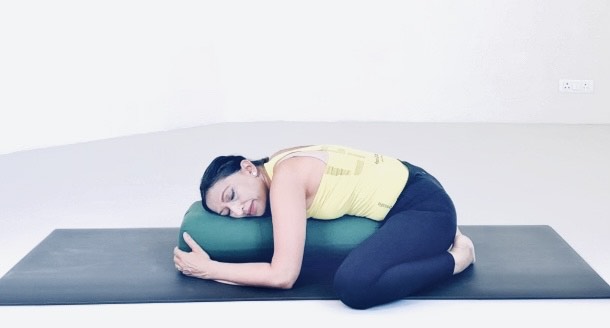This is a familiar scenario for many – tossing and turning, gazing at the ceiling, counting sheep, praying that sleep will come.
Insomnia is a ubiquitous problem, affecting thousands of people worldwide who feel frustrated, helpless and irritable.
Several remedies promise to cure it fully but they often involve strong medication. I suggest try yoga which has a sensible steady approach.
The yogic approach helps one release stress and unwind so that the state of slumber then follows very naturally.
To help my own mother overcome Insomnia, I delved into the ancient wisdom of the science of yoga and I did find my answers there.
I’m sharing a few time-tested poses and practices to overcome insomnia, which I strongly recommend. I also teach these in my Online Yoga Classes in Perth. Do try them to tackle insomnia.
Balasana(Child’s Pose) – The key to releasing pent-up tension is to flop down in a restorative posture like ‘Balasana’ or ‘Childspose’. To assume this pose, start by kneeling on the floor. Bring your big toes to touch and let the heels fall apart. Sit your hips down between your heels and bending your torso down, stretch your arms forward, resting your forehead on the floor. If your forehead does not reach the floor then place a bolster or a cushion or two, to rest your forehead on. If theres a lot of tension around your knees, then place a folded blanket or a cushion between your calves and thighs. This pose lengthens our spine, and brings the spine on top of the heart. This position allows the heart to gravitate, which brings deep release of any pent up stress. The forehead resting down heavily, eases the mind into a state of relaxation. All of this helps us overcome restlessness, which is a roadblock in the path of sleep.
Viparita Karani (Legs Up The Wall Pose) – It isn’t just mental stress that keeps sleep elusive. Often it’s our overactive nervous system. Inverting the body in ‘Viparata Karani’ relaxes the web of nerves, activating the parasympathetic nervous system which is associated with rest. To do it, we have to sit close to a wall and swing our legs up so they can rest against it, forming an L shape with our body. Then we should place a pillow or two under our lower back and hips to get the body into more of a slanting position. We should breathe calmly and hold this upside down position for three minutes.
Corpse Pose (Shavasana) – Sometimes, all one needs to do to sleep well is to just coax our body into a state of relaxation. That’s what ‘Shavasana’ does. It is the ultimate relaxation pose and should be done systematically. All we need to do is lie flat on our back with our palms facing up. Close our eyes and breathe softly, focusing on each and every part of the body, reminding the body parts to relax. We should work our way from from our toes to the top of the head.
Tratak (Practice of Concentrated Gazing) – Just before sleeping at night, sit with a lighted candle one and a half feet in front of us at eye level. There should be no wind or breeze in the room, so the candle flame does not flicker. Sitting on a yoga mat or a carpet is good with the candle on a small table of the correct height. We need to gaze softly and continuously at the tip of the flame for about ten to fifteen minutes, blinking as little as possible. The eyes are the windows to our mind and soul; as the eyes become steady, so does the mind. This is a very effective, sleep inducing practice.
Conclusion
While these postures and techniques might seem straightforward, often some extra guidance can be very helpful. When done incorrectly, postures may not be effective and there is the additional element of inadvertently hurting ourselves. To avoid this enlist help from the professionals. Enroll right away with ‘Yoga With Sapna’ for Online Yoga Classes in Sydney.

